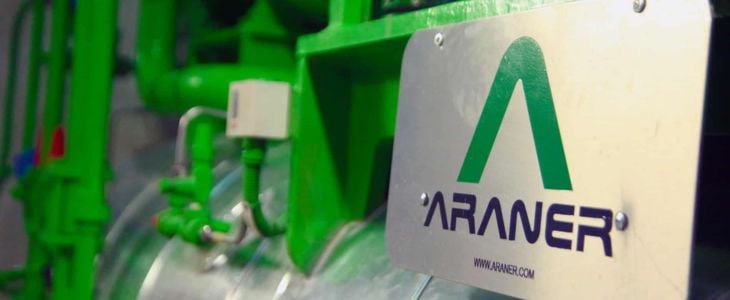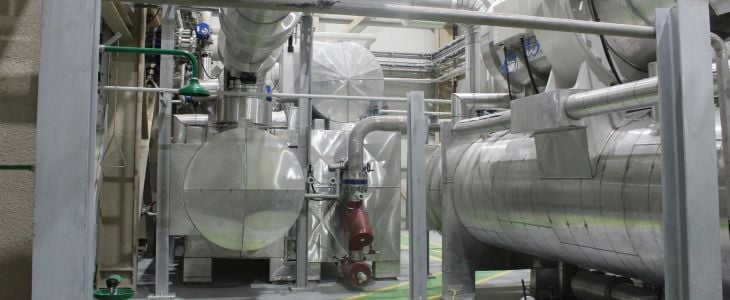The potential of heat pumps for heating and cooling is increasingly understood and employed. The well-designed industrial heat pump has proven to be highly energy-efficient systems (providing up to three times more heat energy than the energy they consume). As a result, this piece of equipment is more and more regarded as a sustainable, cost-effective alternative to traditional heating and cooling technologies.
The fact that many buildings and industrial processes require both heating and cooling (simultaneously or slightly delayed) adds up to this reality. This follows a pronounced increase in cooling demands due to climate change, and a desire to mitigate the climate crisis.
In this context, international organizations and regulatory bodies are favoring heat pumps for heating and cooling. Such is the case of the Future of Heat Pumps' report by the IEA, which recognises this energy infrastructure for affordable and sustainable heating and cooling.
While large heat pumps represent an installed capacity of 2.5 GWth in the EU today (around 1% of the total capacity), growth for heat pump-powered systems is being promoted by both private and public investment. In fact, the installed capacity for large heat pumps is projected to increase by at least 80% by 2030.
Find out what the role of heat pumps for heating and cooling is meant to be.
Heat pump for heating and cooling: a definition
While heat pumps for heating and cooling are essentially the same type of equipment, let’s first look at them separately:
- A heat pump for heating can be defined as a mechanical device that utilizes the principles of thermodynamics to transfer heat from a lower-temperature source to a higher-temperature destination.
- On the other hand, a heat pump for cooling is a mechanical device that utilizes the principles of thermodynamics to transfer heat from the indoor space to the outdoor environment.
Heat pumps that provide both heating and cooling are referred to as "reversible" heat pumps. Their main advantage is that they can switch between heating and cooling modes depending on the desired indoor temperature.
The working principle for a heat pump for heating and cooling
The heat pump operates by using a refrigeration cycle, which involves the evaporation and condensation of a refrigerant gas to absorb and release heat. This is true for both heat pumps for heating and cooling.
During the heating mode, the heat pump absorbs heat from the outdoor air, ground, or water (depending on the type of heat pump) and then increases the temperature of that heat using a compressor. The heated refrigerant is then pumped into the indoor space, where it releases the heat, providing a comfortable and warm environment.

Similar to the heat pump for heating, the cooling heat pump also operates on a refrigeration cycle. However, during the cooling mode, the heat pump reverses its operation: it absorbs heat from the indoor air, cooling it down, and then releases the heat outdoors. The refrigerant gas is compressed, causing it to condense and release heat, and then it is expanded to evaporate and absorb heat from the indoor air, starting the cycle again.
The working principle of both involves the transference of heat (rather than its generation). As such and as we’ll see below, heat pumps are far more efficient than conventional heating technologies such as boilers or electric heaters and can be cheaper to run.
Additionally, heat pumps for cooling represent an energy-efficient alternative to traditional air conditioning systems, which rely solely on electricity to cool the indoor air.
Why the industrial heat pump is living a new golden age
The first and more obvious benefit of using a heat pump for heating and cooling is its flexibility.
This is also true for their capacity to use a wide range of low-temperature heat sources, which is accelerating the decarbonisation of heating. This model is helping operators move away from fossil fuels: as heat pumps consume electricity, they make a much greener alternative for heating and cooling, particularly if said electricity is generated by renewable sources.
The efficiency of industrial heat pumps is yet another reason for their increasing adoption. The efficiency of a heat pump is often expressed by its Coefficient of Performance (COP), which measures the ratio of the amount of heat transferred (or removed) to the amount of energy input required to achieve that transfer.

In the case of heat pumps for heating and cooling, the output of energy in the form of heat is normally several times greater than that consumed by it. That means heat pumps are much more efficient than fossil fuel alternatives, while also being able to reduce operating costs over the system’s lifetime.
Finally, the possibility to incorporate renewable energy and heat and cooling sources is behind the rise of the heat pump for heating and cooling. Models such as ground-source heat pumps incorporate renewable energies and reduce the system’s environmental impact. Wind-powered heat pumps and seawater heat pumps are also increasingly on demand, providing a variety of energy sources to match each project’s availability.
By tapping into renewable sources, heat pumps can contribute to reducing greenhouse gas emissions and fostering a cleaner energy future.
All in all, the rise of the heat pump for heating and cooling is undeniable. The Heat Roadmap Europe project estimates a potential 50% market share for
District Heating by 2050 in Europe. Other reports, such as the DHC Transition Pathways 2050 (by Euroheat & Power, June 2022) foresee the crucial role of the industrial heat pump paired with district heating and cooling to decarbonise the market.
At ARANER, we’re committed to bring the best heating and cooling engineering to each project. As such, we’re specialized in designing and implementing state-of-the-art heat pumps to go with our district cooling and district heating initiatives. If you’re looking for ways to decarbonize your project while ensuring its efficiency, look no further. Get in touch with us and discover how we can help you.










